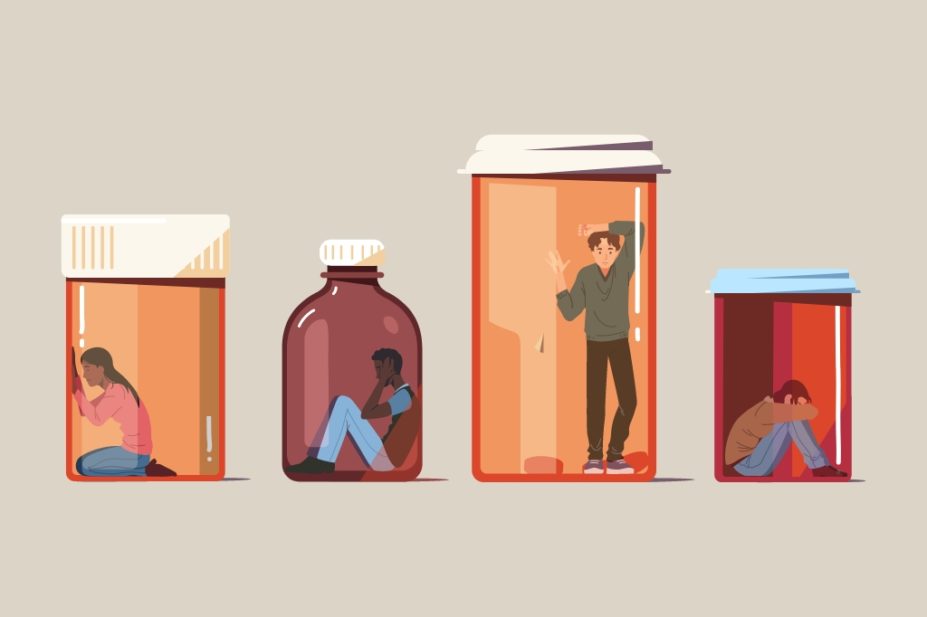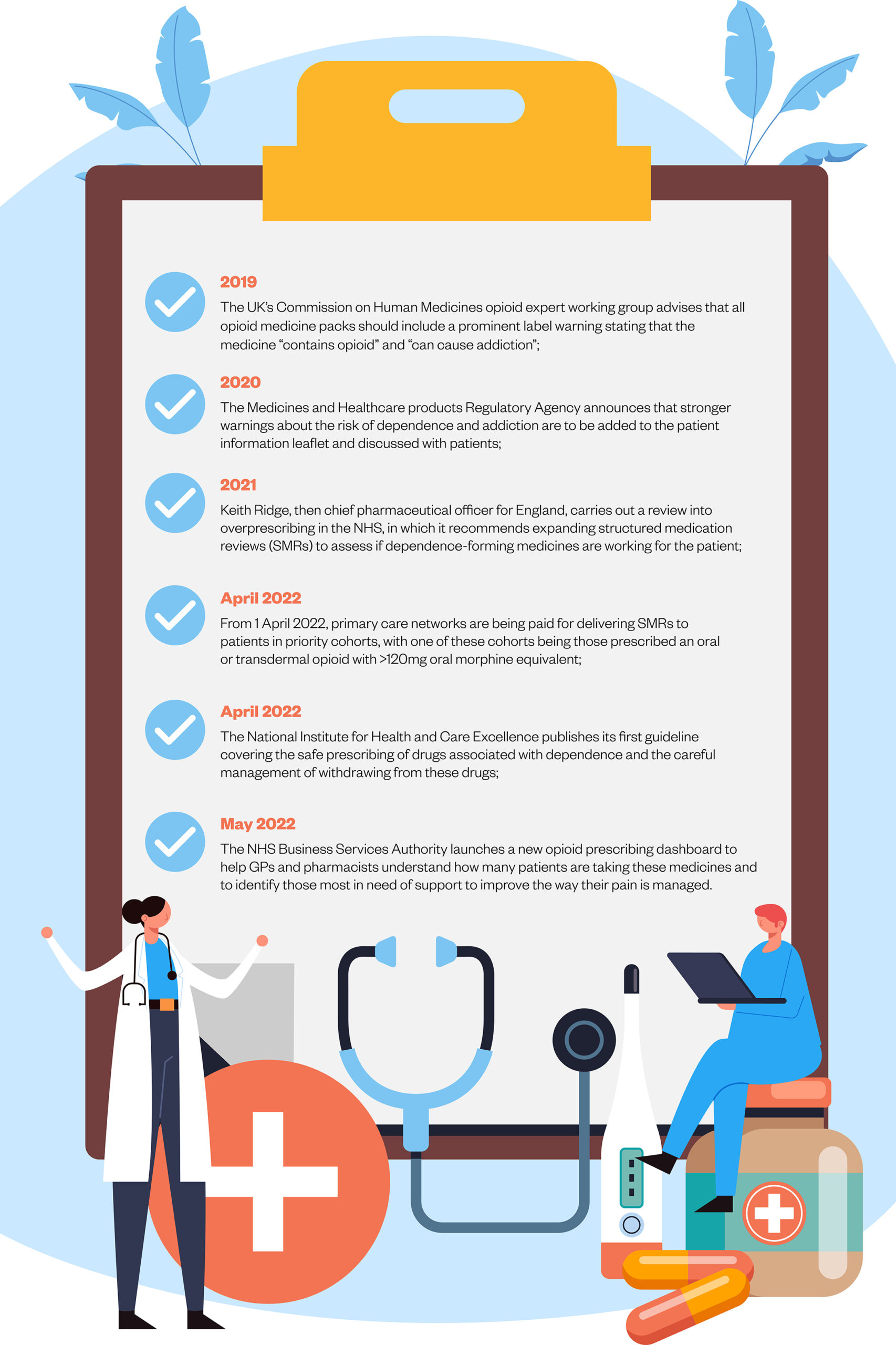
MAG/Shutterstock.com
Over the past 20 years, the use of opioid medicines for chronic pain has become increasingly controversial, with concerns mounting over the associated risks of addiction and harm.
Despite this, opioid prescribing has continued to rise worldwide, reaching the point of a major public health crisis in some countries, including the United States[1].
While opioid prescribing in the UK is yet to reach these levels — in fact, overall prescribing levels for opioids in England have started to decline since reaching a peak in 2016 — there remains a disconnect between ongoing prescribing habits and the lack of evidence to support long-term opioid use.
NHS data show that the number of patients in England being prescribed an opioid for more than three months is rising[2]. These increases appear to have accelerated considerably since 2019, despite an influx of government and NHS reports that have highlighted the risks of opioid dependency and made recommendations to reduce them (see Figure).
In a five-minute appointment with a very distressed patient saying, ‘you wouldn’t treat a dog like this’, the easiest thing to do is just to double the dose
Jane Quinlan, consultant in anaesthetics and pain management at Oxford University Hospitals
“We come back to this time and time again; the messages just aren’t [getting] out there,” says Jane Quinlan, a consultant in anaesthetics and pain management at Oxford University Hospitals, who has a specific interest in and lectures on the topic of prescribed opioid dependence.
“Other support mechanisms for chronic pain — psychology support, video support, general lifestyle support and mental health support in the community — [are] so difficult to access, that in a five-minute appointment with a very distressed patient saying, ‘you wouldn’t treat a dog like this’, the easiest thing to do is just to double the dose.”
In September 2019, Public Health England (PHE) published an evidence review looking at dependence and withdrawal associated with some prescribed medicines, including opioids for non-cancer pain[3]. The report showed that 540,000 patients in England received a prescription for opioid pain medicines continuously between April 2015 and March 2018, despite patient experiences suggesting that prescribing opioid pain medicines for longer than 90 days was associated with overdose and dependence[3].
While action has been taken since the PHE review was published (see Figure), data showing more and more patients being put at risk owing to long-term prescribing of opioids raise questions as to whether these measures are enough to change prescribing practices on the ground.

Looking to the evidence
Although opioids provide effective analgesia for acute pain and in palliative care, there is little evidence of benefit for long-term opioids in patients with persistent non-cancer pain[10]. Since the 1990s, when the message was that any pain could be treated with opioids, providing the dose was high enough, our understanding of the risks, including dependence and opioid-related mortality, has developed considerably[11].
The risk of harm from opioids has been found to increase substantially at doses above an oral morphine equivalent of 120mg/day, but without any increased benefit[12]. In addition, evidence suggests that long-term opioid therapy — which is mostly defined as 90 days or more — is where the harms start to outweigh the benefits[13].
Despite this, around 3% of patients with chronic pain have received continuing prescriptions for opioids for three years or more[14]. Many of these people will be on a high dose but have continued pain and a poor quality of life[15].
One of the main issues is that tapering or stopping opioids needs careful planning and collaboration. Withdrawal symptoms with dependence-forming medicines, which can include vomiting, diarrhoea, anxiety and insomnia, may last many months and can affect a patient’s physical, mental and social wellbeing[14]. As a result, fear of withdrawal can create a barrier to discussing opioid reduction for some patients[15].
Reflecting this, NHS England and Improvement (NHSE&I) has advised an “initial focus” on reducing initiation of these medicines, before moving on to deprescribing.
The British Pain Society recommends a trial approach when starting patients on opioids — giving a maximum of 120mg morphine equivalent dose in 24 hours. It says that patients who may benefit from opioids in the long term will demonstrate a favourable response within two to four weeks and those who do not are unlikely to gain benefit[16].
Following this recommendation, there has been a drive for primary care to lead on opioid reduction, but little guidance advises on how to achieve it.
Going it alone
As a result, some particularly driven healthcare professionals have been taking matters into their own hands.
One of these is Deborah Hollywood, a GP pharmacist based at York Road Group Practice in Cheshire. In June 2020, Hollywood started by selecting patients who were taking more than 120 morphine milligram equivalents (mme) and initiating a reduction of 5mme every two weeks.
Between June 2020 and January 2021, Hollywood’s practice achieved an opioid dose reduction of more than 450,000mme. But she didn’t stop there; now her patient list has expanded to include those on smaller doses.
“Consultants, and some GPs, previously were a bit ‘throw the book at it’ [with tapering] — [there were] massive drops down, [they] didn’t really know how to handle it, [it] didn’t work and then the patient ended up stuck on it.
“It seems to work better if you’re a bit gentle with them and you’re really there to support them.”
I’m still seeing patients who have transferred to us, who have recently been titrated up by doctors — and you just think, ‘what’s your excuse now?’
Deborah Hollywood, GP pharmacist based at York Road Group Practice in Cheshire
Now, Hollywood gets messages from local pain clinics for her help with tapering and has taken on several patients on very high dose opioids from other local practices.
“I’m still seeing patients who have transferred to us, who have recently been titrated up by doctors — and you just think, ‘what’s your excuse now?’”
She says it is important to take the time to explain to patients the limitations of the medicine.
“I’ll explain to them about tolerance and about the fact that we did what we thought was best but we know better now, and the fact that all we’re doing is making them more dependent on this medication.
“I could sit there and quite happily increase the dose and be the good guy again. But I know I’ll see that patient in a couple of months [and they] will be telling me that pain is awful again.”
More than pain
For many patients taking long-term opioids, dependence on their medicines goes beyond pain management.
“A lot of these patients who’ve been [taking] opioids and other things for 20 years have become medication reliant,” explains Quinlan.
“They often also have psychological comorbidities — anxiety, depression — that really hold them back from moving on and taking a bit more control.
“Taking away their opioids takes away their crutch,” she adds.
The All-Party Parliamentary Group for Prescribed Drug Dependence (APPGPDD) has been demanding appropriate services for those affected by prescribed drug dependence for many years, including the creation of a national helpline (see Box).
Taking away their opioids takes away their crutch
Jane Quinlan, consultant in anaesthetics and pain management at Oxford University Hospitals
The group, alongside others, was particularly disappointed with National Institute for Health and Care Excellence guidance on dependence and withdrawal, published on 20 April 2022, saying the guidance “fail[ed] to provide simple instructions for slow tapering, which is the most important intervention for safe withdrawal”[7].
In addition, the Royal Pharmaceutical Society (RPS) said that it would have been helpful if the guidance included evidence-based information on tapering.
“This would have given prescribers confidence in their recommendations and a starting point for discussion with their patient, allowing them to formulate a plan together, which would afford patients the best chance of successful withdrawal,” said Laura Wilson, policy and practice lead for the RPS in Scotland, when the final guidance was published.
To make up for the lack of central guidance around opioid tapering, Quinlan has developed her own, which she now shares widely.
“I’ve got an opioid calculator so that the GP can work out the morphine equivalent dose, and then see how that fits with the 120 milligrams recommended maximum. And then I’ve got tapering schedules where you plug in the patient’s dose and it calculates the whole thing.”
Quinlan’s method of tapering is centred on shared decision making.
“I always turn the computer screen to the patient and say, let’s work it out together … then the computer is the one that says they’re on too much rather than me. So, we can work together to make the decision, which is just so much better.”
Box: The elusive helpline
The All-Party Parliamentary Group for Prescribed Drug Dependence (APPGPDD), alongside the British Medical Association, has advocated for the creation of a national helpline for prescribed drug dependence for several years. It was also a recommendation in the 2019 Public Health England evidence review looking at dependence and withdrawal associated with some prescribed medicines[3].
However, almost three years later, a helpline is yet to be created.
“We just keep being told that the Department of Health [and Social Care] is considering options of how to implement it,” says Anne Guy, secretariat coordinator of the APPGPDD.
“We were given a name of somebody who was in charge of doing that, but then they moved on. We haven’t been given another name yet.”
The APPG is determined to continue working towards the establishment of a helpline.
“We’ve got a group called [the lived experience advisory panel] for prescribed drug dependence [made up of] people with lived and professional experience.
“We’ve specified what the helpline should offer, and we’re starting to specify the training that people would need to staff the helpline. So, we’re trying to be as ready as possible.”
COVID-19
A significant proportion of patients taking long-term opioids will be on repeat prescriptions and may be falling under the radar, explains Quinlan, but she says this is where pharmacists come in.
“Community pharmacists have got such an important role to look at the patients on a repeat prescription, that no one is actually checking,” she says.
A good idea in theory but perhaps not that straightforward in practice. Research due to be presented at the Society for Academic Primary Care annual scientific meeting on 6 July 2022 highlights that community pharmacists, while positive about additional opportunities to support patients taking opioids, say they have insufficient patient information to expand their clinical role in this area.
Duncan Hill, a specialist pharmacist in substance misuse at NHS Lanarkshire, says that more medication reviews are needed to check whether or not an opioid is still of value and is not causing harm.
“It’s [about] getting people educated, don’t keep persevering [with] higher doses. Check in — sometimes it’s a change in therapy that you need.”
However, during the COVID-19 pandemic, many consultations were moved online or via telephone, making regular medication reviews for patients on opioids more difficult.
“We changed most of our appointments to telephone,” explains Quinlan.
“And actually, for a lot of chronic pain patients, that was much easier than getting in a car and driving half an hour with their back pain,” she adds.
“But you don’t get that kind of personal interaction in the same way as you do face to face. And, I suspect, when GPs were overwhelmed, addressing some of the opioid use was just put on hold.”
Sometimes, it is not just about seeing the patient face to face that is useful for those assessing opioid use — Quinlan says patients’ relatives can often be quite useful.
“Talking to the patient and saying ‘are you having any problems with forgetfulness, or poor memory or anything like that?’ And they’re saying ‘no, no, it’s fine. I think we should just leave things as they are’, it’s [often] the relative behind that’s going ‘no, it’s terrible!’.”
Don’t keep persevering [with] higher doses. Check in — sometimes it’s a change in therapy that you need
Duncan Hill, a specialist pharmacist in substance misuse at NHS Lanarkshire
Acknowledging the difficulties with conducting consultations remotely, Hollywood says her practice was “adamant” that it would carry on seeing patients through the pandemic.
“People were brought in regardless,” she says, although she admits her practices are “a bit skewed because all my GPs are very opioid-savvy now”.
This was just as well, as more and more patients were being directed back to them.
“We did have a problem with pain clinic teams racking up ridiculous doses and then saying, there’s nothing more I can do here. Go have your patient back.”
Hill believes that the acceleration seen in the number of opioids being prescribed long term during the pandemic may not be a coincidence, and needs to be tackled head on.
“There’s a significant jump there… there’s no other big jump like that. And so, I would say the pandemic has possibly increased the amount of repeat prescribing,” he says.
“The worry is that the jump hasn’t stopped.”
Central guidance
Fortunately, as we start to emerge from COVID-19, it seems likely the reviews that Hill is calling for could quickly become a part of routine care.
From 1 April 2022, primary care networks (PCNs) are being paid for delivering structured medicine reviews (SMRs) to patients in priority cohorts, such as those prescribed an oral or transdermal opioid with more than 120mg oral morphine equivalent[8].
NHSE&I recommends that, “where possible”, practices should involve practice-based clinical pharmacists and local community pharmacists in their quality improvement plans.
However, without any central guidance on how to taper patients, there are concerns among experts as to how this might work.
“The trouble is that the structured medication reviews, in theory, are going to throw up a whole cohort of patients who should be coming off, who are being encouraged to come off, but without any level of support,” says Anne Guy, secretariat coordinator of the APPGPDD.
“Structured medication review documents contain no reference to withdrawal support at all, which is barking, in my opinion.”
And Quinlan argues that incentivising practices to bring opioid prescribing down could make matters worse. “I’ve seen lots of patients where they’ve had the opioids just reduced with no discussion, no safety netting, but they’re just ticking a box and this might make it worse,” she says.
The structured medication reviews, in theory, are going to throw up a whole cohort of patients who should be coming off [opioids]…but without any level of support
Anne Guy, secretariat coordinator of the All-Party Parliamentary Group for Prescribed Drug Dependence
Guy adds that NHS England is due to publish a commissioning framework to support people with prescribed drug dependence imminently.
“This is going to require clinical commissioning groups and integrated care systems to actually put in place support services for prescribed drug dependence. And that should work hand-in-hand with the SMR.”
The Pharmaceutical Journal approached NHSE&I to ask when the commissioning framework would be published but received no reply before publication.
In the meantime, it will be left up to prescribers to establish their own tapering strategies, or for experts such as Quinlan and Hollywood to share theirs.
“Something central needs to be sorted,” says Hollywood.
“A lot of pharmacists [are] just giving it a go [but] it would be a lot easier to have something central that they could [refer to]. And also, if it’s set up nationally, there’s a bit more confidence from patients as well.”
For her, tapering patients off opioids has been a significant commitment.
Her advice? “Don’t start lots of people at the same time because they’ll need to lean on you emotionally. And it will also be more time consuming than you think.”
Read more: In figures: the rise in long-term opioid use
- 1Schreiber M. ‘Completely devastating’: US passes 1m overdose deaths since records began. The Guardian. 2022.https://www.theguardian.com/us-news/2022/may/11/us-overdose-deaths-total-data (accessed 7 Jun 2022).
- 2NHSBSA Medication Safety Indicators. Catalyst. https://catalyst.services.nhsbsa.nhs.uk/analytics/saw.dll?Dashboard&PortalPath=%2Fshared%2F%20ePACT2%2F_portal%2FMedication%20Safety%20Indicators&P1=dashboard&Action=Navigate&ViewState=g9lql052j2ku8bf7irn9cdcmo6&P16=NavRuleDefault&NavFromViewID=d%3Adashboard~p%3A8qvj24gcsk0tmf86 (accessed 7 Jun 2022).
- 3Dependence and withdrawal associated with some prescribed medicines: An evidence review. Public Health England. 2019.https://assets.publishing.service.gov.uk/government/uploads/system/uploads/attachment_data/file/940255/PHE_PMR_report_Dec2020.pdf (accessed 7 Jun 2022).
- 4All opioid medicines to contain clear warnings about addiction, health secretary announces. The Pharmaceutical Journal. 2019. doi:10.1211/pj.2019.20206486
- 5UK regulator strengthens opioid warnings. Gov.uk. 2020.https://www.gov.uk/government/news/uk-regulator-strengthens-opioid-warnings (accessed Jun 2022).
- 6Good for you, good for us, good for everybody. Department of Health and Social Care. 2021.https://assets.publishing.service.gov.uk/government/uploads/system/uploads/attachment_data/file/1019475/good-for-you-good-for-us-good-for-everybody.pdf (accessed Jun 2022).
- 7Medicines associated with dependence or withdrawal symptoms: safe prescribing and withdrawal management for adults. National Institute for Health and Care Excellence . 2022.https://www.nice.org.uk/guidance/ng215 (accessed 7 Jun 2022).
- 8Network Contract Directed Enhanced Service Investment and Impact Fund 2022/23: Updated Guidance. NHS England. 2022.https://www.england.nhs.uk/wp-content/uploads/2022/03/B1357-investment-and-impact-fund-2022-23-updated-guidance-march-2022.pdf (accessed 7 Jun 2022).
- 9Opioid Prescribing Comparators dashboard. NHS Business Services Authority. https://www.nhsbsa.nhs.uk/access-our-data-products/epact2/dashboards-and-specifications/opioid-prescribing-comparators-dashboard (accessed Jun 2022).
- 10Guidance for opioid reduction in primary care. Oxford University Hospitals NHS Foundation Trust. 2017.https://www.ouh.nhs.uk/services/referrals/pain/documents/gp-guidance-opioid-reduction.pdf (accessed 7 Jun 2022).
- 11DeWeerdt S. Tracing the US opioid crisis to its roots. Nature. 2019;573:S10–2. doi:10.1038/d41586-019-02686-2
- 12Opioids Aware. Faculty of Pain Medicine of the Royal College of Anaesthetists . https://www.fpm.ac.uk/opioids-aware (accessed 6 Jul 2022).
- 13Abdel Shaheed C, McLachlan AJ, Maher CG. Rethinking “long term” opioid therapy. BMJ. 2019;:l6691. doi:10.1136/bmj.l6691
- 14Craig M. Update on Quality Outcomes Framework changes for 2022/23. NHS England and NHS Improvement. 2022.https://www.england.nhs.uk/wp-content/uploads/2022/03/B1333_Update-on-Quality-Outcomes-Framework-changes-for-2022-23_310322.pdf (accessed 7 Jun 2022).
- 15Quinlan J, Willson H, Grange K. Hopes and fears before opioid tapering: a quantitative and qualitative study of patients with chronic pain and long-term opioids. British Journal of Pain. 2020;15:120–8. doi:10.1177/2049463720974053
- 16Opioids for long term pain. Faculty of Pain Medicine of the Royal College of Anaesthetists. https://fpm.ac.uk/opioids-aware-clinical-use-opioids/opioids-long-term-pain (accessed 7 Jun 2022).


